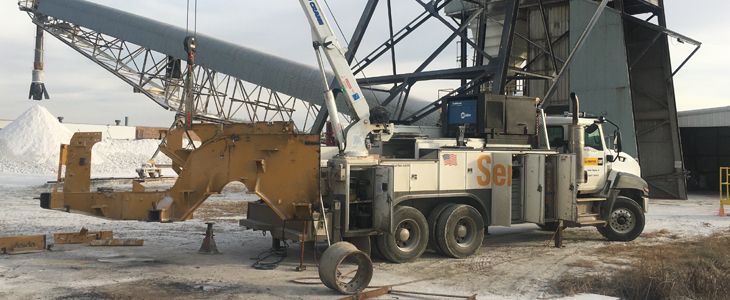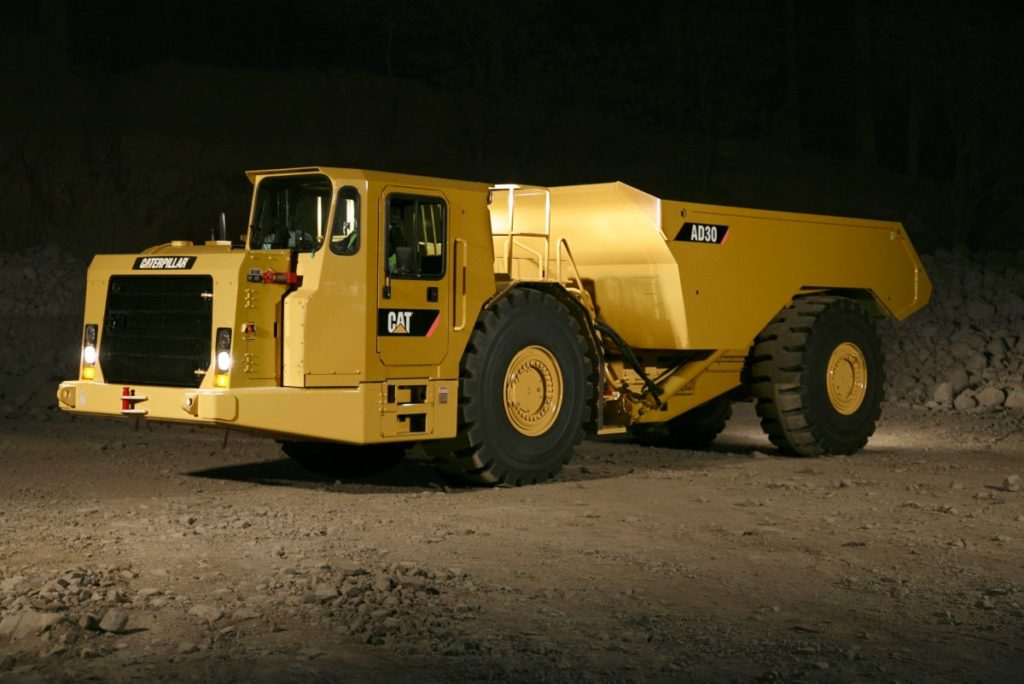U.S. Gypsum’s (USG) Sperry mine in Iowa, USA, has added another large piece of Cat equipment to its underground loading and hauling fleet – this time a 30-t payload Cat AD30 underground truck.
Located 192 m below the surface and accessible only by a shaft measuring 1.5 m x 1.8 m, the only way to get the new equipment into the mine was to disassemble, lower and reassemble it underground.
USG has successfully commissioned three Cat® R1600 underground loaders over the last decade, relying on Altorfer Cat, the Cat dealer serving a three-state region that includes the Sperry location near Mediapolis, Iowa.
Several of the Altorfer team members responsible for the first mine transfer of the R1600s were also on hand for the AD30 transfer, including Sales Representative, Jeff Krug, and Field Technician, Chris Wolf.
“Altorfer and United States Gypsum have had a relationship for many years, starting with surface equipment,” Krug says. “When the opportunity to offer Cat mining solutions for their underground equipment materialised, the mine quickly realised there were many of the same components in the underground machines as on the surface. Parts availability and a strong service partnership made it much easier for them to switch to Cat machines.”
Since 1959, the underground Sperry operation has produced gypsum and now produces over 590,000 t/y of raw gypsum. Most of the mine’s gypsum is used in the on-site manufacturing plant, where USG makes Sheetrock® brand wallboard. Gypsum also has medicinal and agricultural uses.
The room and pillar mine has an average ceiling height of about 3 m. Gypsum is mined using the drill and blast method, then the rock is hauled to the mine’s crusher.
“The physical size of the mine has always been a limiting factor for selection of mobile equipment,” Dennis Hollingsworth, former Mine General Foreman, says. “When Cat started producing more underground equipment, it created a new choice for us – first with the R1600s, and now the AD30.”

After the successful implementation of Sperry’s R1600 fleet, Altorfer developed best practices for the mine transfer process that were shared with other dealers around the world. Taking advantage of those lessons learned, the Altorfer team spent several weeks planning and collaborating with the Sperry team before beginning the AD30 transfer.
First, the AD30 arrived at Altorfer’s Cedar Rapids, Iowa, facility, where it was adapted to the specific requirements of the mine. The bed was removed and modified so it could meet the 1.8-m height requirement for loading. In addition, tyres were replaced with a lower profile tyre to meet the maximum height requirement of the mine.
Finally, the machine arrived on the surface of the Sperry mine. Joining Wolf were two Sperry employees who also worked on the R1600 mine transfers: Mine Maintenance Supervisor, Doug Edle, and Technician, A.J. Kuisle.
“Taking the machine apart is the most important part of the process,” Wolf says. “You need to remove things in a precise order, be two to three steps ahead and have a plan for keeping track of everything.”
The team removed the rear axle and all the cooling lines and wiring harnesses from the rear frame, then separated the rear frame from the front frame. Then they tackled the front frame, removing the cab, engine transmission and front axle and lowering them into the mine. Next was the removal of the fire suppression system and wiring harnesses, as well as hoses and valves.
Once everything was removed from the front frame, the team welded on fixtures they would use to line up the frame pieces for reassembly. Then the cutting began, with oxyacetylene torches and an air arc being used to cut the frame into smaller pieces that would fit down the shaft.
Once all the pieces and parts were down the shaft, the AD30 was cleaned and the welding team put the frame back together. Then Wolf and Kuisle got busy reassembling the rest of the machine.
“It took about three weeks to get it back together and running,” Wolf said. “We were very particular to make sure that everything was assembled correctly, that there were no hoses or wires rubbing. Then we started it up and installed the bed and made sure everything was working correctly.”

Hollingsworth is proud of the teamwork involved in the machine transfer. “Getting new equipment underground has always been a challenge,” he says “Bringing a new piece of equipment underground and re-assembling it has always been a process that our mechanics take pride in being able to accomplish. Chris Wolf has a been a part of that process four times now, and I think, feels the same way. He has done a great job helping with the teardown and reassembly of all four Cat machines.”
Altorfer’s role in the life of the new AD30 didn’t stop once the machine was assembled underground. Before handing off the keys, the team took it for a test drive. When the testing was complete, Wolf provided training to the employees who would be operating the new truck.
“The training process went well,” Hollingsworth says. “Chris came in on both shifts and trained all of the operators. It’s something we’ve come to expect from Altorfer that we don’t typically get from other manufacturers.”
And finally, about four-and-a-half weeks after the mine transfer process began, the AD30 went to work.
Hollingsworth said the mine’s satisfaction with its Cat R1600s, the long life and rebuildability of Cat machines, and the quality of Altorfer’s service all contributed to the decision to purchase the AD30. “The AD30 has been a great addition to the mine fleet,” he says. “The truck is running great. The operators took to it quickly. They like the way it drives and performs.”
Just like Sperry mine’s other Cat equipment, the new machine will be supported throughout its life by Altorfer, with more new Cat machines continuing to join the mine’s fleet in the years to come.











